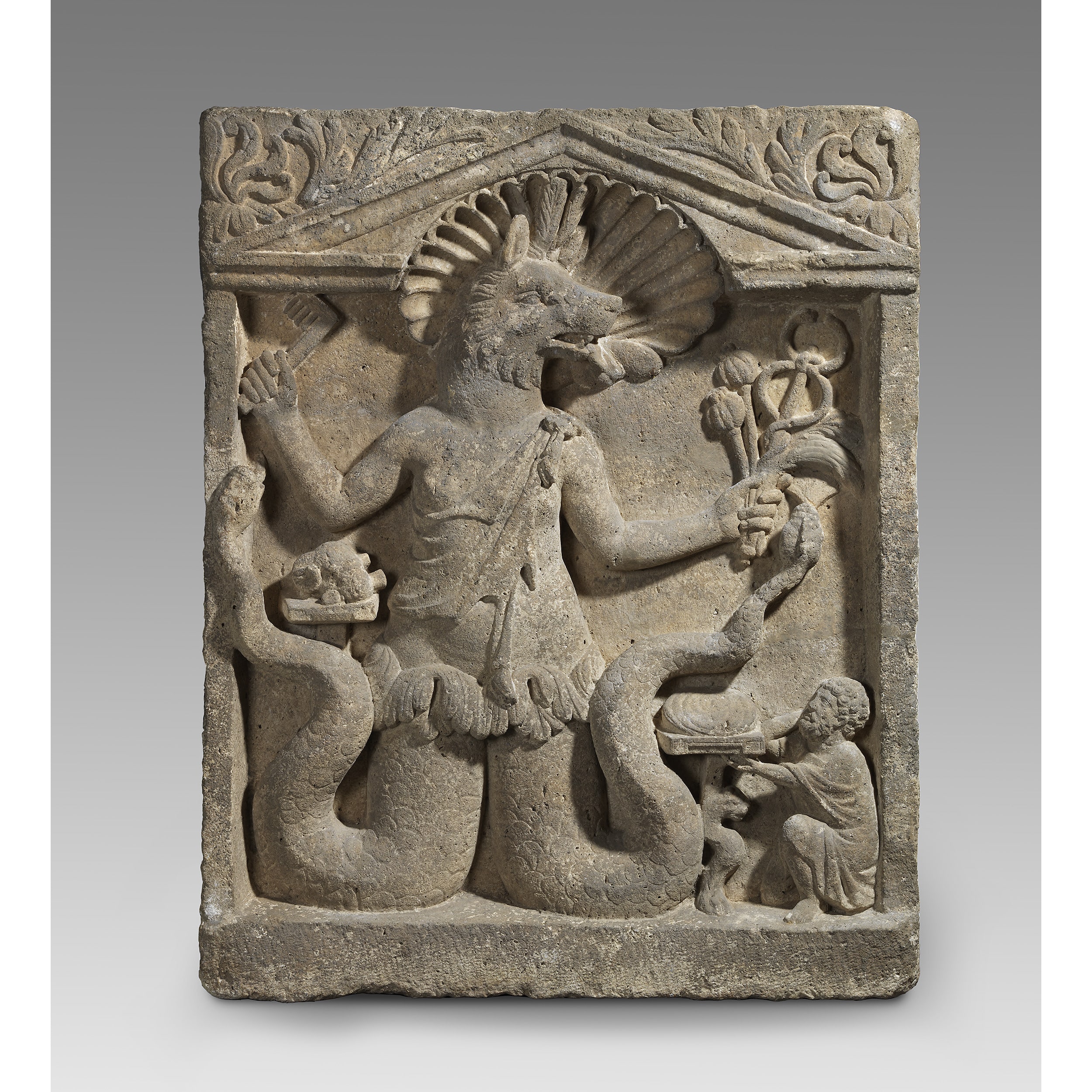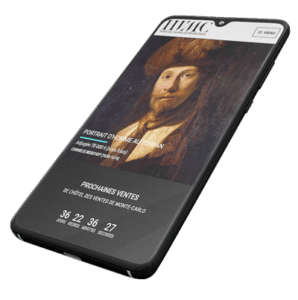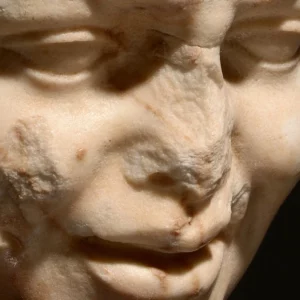Calcaire
74 x 89,5 x 10 cm
Art romain, IIIe siècle
Provenance
Ancienne collection du Sud de l'Allemagne dans les années 1980
Vente Anonyme; Gorny & Mosch, Munich, 22 Juin 2005, lot 99
Ex-Vente Christie's NY, 16/12/2010, lot 197 ($ 200 000 - 300 000)
Collection de la Fondation Gandur pour l'Art, Suisse
Publication
MELA. C., MÖRI. F., Alexandrie la Divine, vol.II, fig. 143
Pour une iconographie similaire
Statuette d'Anubis anguipède, Musée National de Varsovie, Inv. nr 148140 MNW (fig.1)
Statue d'Hermanubis en marbre, IIe siècle, Musei Vaticani, Museo Gregoriano egizio (fig.2)
Intaille sur jaspe figurant Abraxas, art romain Ier-IIIe siècle, Cabinet des Médailles, Paris, Schlumberger.318, (fig.3)
Fragment de bas-relief de Vyala Yaksha, Ier siècle av. J.-C., Curzon Museum of Archaeology, Mathura, ACCN 42-2944 (fig.4)
Sculptée en haut-relief, cette scène présente à l'intérieur d'une architecture en forme d'aedicula (chapelle), dont le fronton est orné au centre d'une coquille creusée, une divinité à forme composite.
Elle présente une tête de chacal, un corps humain et deux serpents en guise de jambes. Il s'agit en fait d'une forme peu usuelle d'Hermanubis en Abraxas. Une hybridité rare et particulièrement bien exécutée. Les écailles des serpents sont finement marquées, leurs têtes remontant dans l'espace laissé libre de part et d'autre.
Le torse et les bras du personnage sont ceux d'un homme viril, et la tête est celle d'un chien ou loup tournée vers la gauche (que l'on identifiera comme celle du dieu égyptien Anubis à tête de chacal).
En guise de vêtement, cet être mi-humain, mi-animal porte un exomide, un vêtement de travail, formé de la peau d'un animal aux sabots fendus, noué sur l'épaule gauche pour dégager le bras droit. De la main droite, il brandit une clé aux dents bien marquées, et dans celle de gauche, un caducée, deux pavots et deux palmes, tandis que de sa tête saillent deux épis de blé.
Sur une première table d'offrande à gauche de l'image, est posée une tête de bélier coupée. Une la seconde à droite, pourvue d'un seul pied, à tête et patte de lion, fait pendant à la première, dans la partie gauche; un gâteau y est posé. Figuré à une petite échelle, un homme barbu se tient dans une attitude suppliant un genou à terre devant la table, et présente le gâteau et lève la tête vers le dieu hybride.
L'identification précise de cette divinité syncrétique semble peu évidente à première vue. Il faut y avoir principalement l'association de deux divinités; Hermanubis, association entre les dieux psychopompes grec et égyptien Hermès et Anubis (attributs chthoniens tels que le caducée, la clé, les pavots et les épis) (fig.1-2). Et Abraxas, que l'on retrouve fréquemment sur les intailles gnostiques, doublement anguipède mais généralement représenté avec une tête de coq et un fouet dans la main (fig.3).
Cette représentation associe donc deux divinités psychopompes sous la forme d'une seule Hermanubis (apparue à l'époque ptolémaïque) et Abraxas qui de part son anatomie renvoie aux forces du mal qui jaillissent de la terre.
En outre, la tête de bélier sur la table de gauche, très singulière, rappelle une offrande spécifique au loup d'autant que les habitants de Lycopolis comptaient parmi les consommateurs de viande de cet animal (PLUTARQUE, Isis et Osiris, 72). Quant à la peau animale, qui sert d'exomide à la divinité, elle pourrait rappeler la peau d'âne, animal impur présentant des affinités avec Typhon (ibid., 30), preuve que le mal et la stérilité seraient ici vaincus par Anubis, fils d'Osiris et d'Isis tandis que les épis de la vie et de la renaissance jaillissent, eux, de la tête du dieu. Ainsi, l'orant à droite du monument implore une divinité protectrice dont on accentue le caractère terrifiant. Ce monument en calcaire, probablement alexandrin, aurait des chances de provenir de l'une des nécropoles d'alexandrie fréquentées au IIIe siècle de notre ère.
A Roman Alexandrian limestone gnostic relief sculpted in high relief depicting Hermanubis-Abraxas in an offering scene. 3rd century A.D.
Sculpted in high relief, this scene presents inside an architecture in the form of an aedicula (chapel), the pediment of which is decorated in the center with a hollowed-out shell, a deity in a composite form.
It presents a jackal's head, a human body and, as legs, two snakes. This is actually an unusual form of Hermanubis en Abraxas. A rare and particularly well-executed hybridity. The scales of the snakes are finely marked, their heads rising in the space left free on either side.
The figure's torso and arms are those of a virile man, and the head is that of a dog or wolf facing left (which will be identified as that of the Egyptian god Anubis with the head of a jackal).
By way of clothing, this half-human, half-animal being wears an exomide, a work garment, formed from the skin of an animal with cloven hooves, tied on the left shoulder to release the right arm. With his right hand, he brandishes a key with well-marked teeth, and in his left, a caduceus, two poppies and two palms, while from his head protrude two ears of corn.
On a first offering table to the left of the image, is placed a severed ram's head. A second table of offerings, on the right, provided with a single leg, with the head and paw of a lion, is a counterpart to the first, in the left part; a cake is placed there. Figured on a small scale, a bearded man stands in a pleading attitude on one knee in front of the table, and presents the cake and raises his head towards the hybrid god.
The precise identification of this syncretic deity seems unclear at first sight. There must be primarily the association of two deities; Hermanubis, association between the Greek and Egyptian psychopomp gods Hermes and Anubis (chthonian attributes such as the caduceus, the key, the poppies and the ears of corn) (fig.1-2). And Abraxas, who is frequently found on Gnostic intaglios, doubly anguiped but generally represented with a rooster's head and a whip in his hand (fig.3).
This representation therefore associates two psychopomp deities in the form of a single Hermanubis (appeared in the Ptolemaic period) and Abraxas which, due to its anatomy, refers to the forces of evil which spring from the earth.
In addition, the ram's head on the left table, very singular, recalls a specific offering to the wolf, especially since the inhabitants of Lycopolis were among the consumers of this animal's meat (PLUTARCH, Isis and Osiris, 72). As for the animal skin, which serves as an exomide for the divinity, it could recall the skin of an ass, an impure animal presenting affinities with Typhon (ibid., 30), proof that evil and sterility would be vanquished here by Anubis , son of Osiris and Isis, while the ears of life and rebirth spring from the head of the god. Thus, the praying person on the right of the monument implores a protective deity whose terrifying character is accentuated. This limestone monument, probably Alexandrian, would likely come from one of the necropolises of Alexandria visited in the 3rd century AD.
*Pour les acheteurs de l’Union Européenne : Ce lot est vendu sous le statut d’importation temporaire. Les acheteurs devront s’acquitter uniquement de frais de dossiers suppléentaires. Aucune TVA à l’importation ne leur sera facturée.
Buyers inside European Union : The lot is sold under Temporary Import status. Buyers will only have to pay additional paperworks fees. No import VAT will be charged to them.
Description complète







